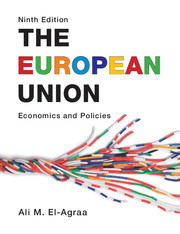Book contents
- Frontmatter
- Contents
- Figures
- Tables
- Boxes
- Contributors
- Preface
- A reader’s guide
- Abbreviations
- 1 General introduction
- Part I EU history, institutions and legal dimension
- Part II EU market integration
- Part III EU monetary integration
- Part IV The single European market
- Part V EU budget and structural policies
- Part VI EU external relations
- External trade policy
- 25 The EU and the developing world
- Part VII The future of the EU
- Bibliography
- Author Index
- Index
- References
External trade policy
from Part VI - EU external relations
- Frontmatter
- Contents
- Figures
- Tables
- Boxes
- Contributors
- Preface
- A reader’s guide
- Abbreviations
- 1 General introduction
- Part I EU history, institutions and legal dimension
- Part II EU market integration
- Part III EU monetary integration
- Part IV The single European market
- Part V EU budget and structural policies
- Part VI EU external relations
- External trade policy
- 25 The EU and the developing world
- Part VII The future of the EU
- Bibliography
- Author Index
- Index
- References
Summary
Introduction
The external trade policy of the European Union (EU) involves nearly one-fifth of world trade. Hence an understanding of the principles and practice of EU trade policy, the Common Commercial Policy (CCP), is of vital importance for understanding the EU’s role and impact on the global economy.
With growing trade, falling transaction costs, better information and communication technologies, global economic integration is increasing; ‘globalization’ is on the rise (if one wanted to be trendy). Global production chains are common in most industries and are essential for maintaining competitiveness. Thus the EU’s external trade policy has an increasing role to play in promoting the competitiveness of the European industries and ensuring EU economic growth.
- Type
- Chapter
- Information
- The European UnionEconomics and Policies, pp. 383 - 400Publisher: Cambridge University PressPrint publication year: 2011



